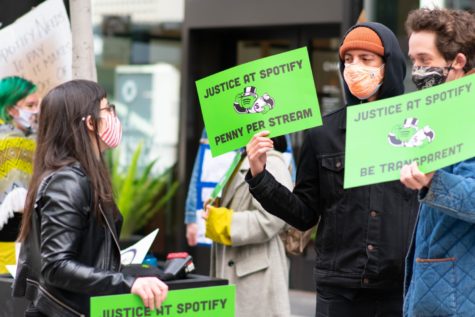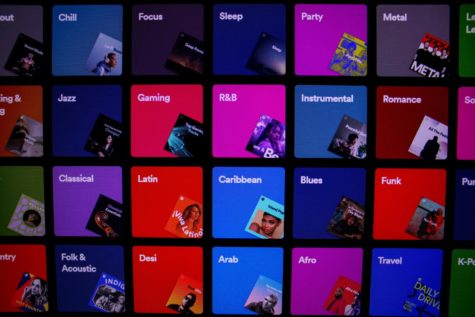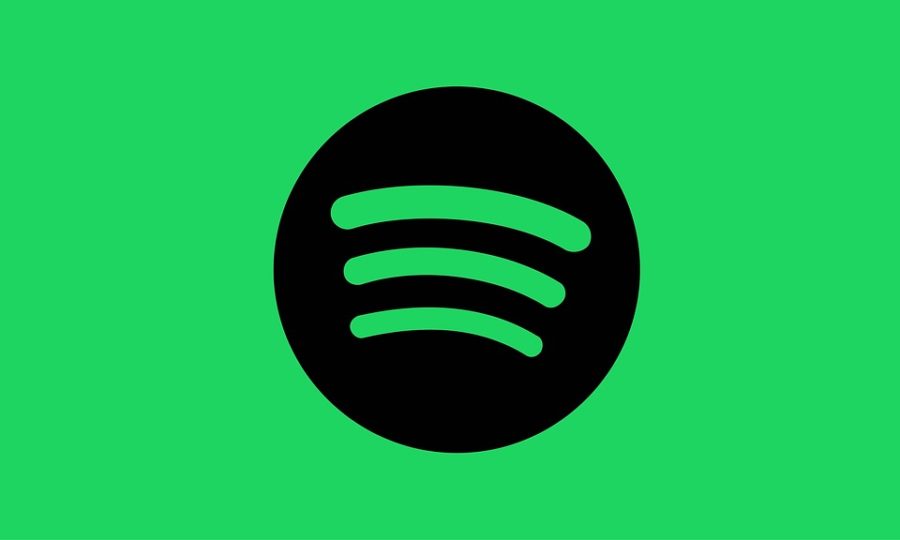What’s the Deal With Spotify?
A look into the controversial world of Spotify, and its pros, and cons.
Spotify had about 162.4 million paying subscribers in 2021, making it the largest music streaming service by far.
In 2021, Spotify was the largest music streaming service in the world. With a market share of 31 percent, Spotify had about 162.4 million paying subscribers. This number came in at a 16 percent higher market share than that of the second most popular streaming service, Apple Music. And the disparity didn’t even take into account the more than half of Spotify users who stuck with Spotify’s Free feature (an option that Apple Music does not offer). Despite frequent, highly-publicized controversies, Spotify continues to dominate. Although the business dropped slightly from a 33 percent market share in 2020, it benefited from an overall increase in the amount of people subscribing to music streaming services, and thus brought in a greater revenue despite its relative drop in popularity. It is safe to say, the company has “room” to drop; the reign of Spotify is unlikely to end anytime soon.
Shortly after the beginning of 2022, Spotify found itself in one of its biggest controversies yet. On January 24th, 2022, world-famous artist Neil Young announced he would be taking his music off of Spotify, citing podcaster Joe Rogan’s show for “spreading false information about vaccines,” as his primary reason. Joe Rogan, who hosts “The Joe Rogan Experience,” is Spotify’s most prominent podcaster. New “Experience” episodes drop every few days and garner tens of millions of streams. In May 2020, Spotify announced a licensing agreement deal to make “The Joe Rogan Experience” exclusive to Spotify. The deal was reportedly worth $200 million dollars, giving Spotify reason to be highly invested in Joe Rogan’s success.

After Neil Young’s announcement, various content creators offered support. Singer Joni Mitchell was the most notable artist to do so, following suit in the removal of her music from Spotify. Acting quickly, Spotify CEO Daniel Ek posted a note on the company’s platform rules on January 30th, 2022. He announced a plan to add content advisory warnings to podcast episodes that discuss COVID-19. Following a non-combative apology video from Rogan, it looked like things were returning to normalcy for Spotify. Although many remained persistent in their criticism of Joe Rogan and Spotify’s endorsement of his platform, others commended the company’s dedication to free speech.
On February 4th, 2022, an artist by the name of India.Arie shared clips of Joe Rogan using the n-word on his podcast. Although Spotify went on to remove more than 100 “Joe Rogan Experiences” episodes from their platform, the public took note of the fact that this content had existed on the platform until then, and that it hadn’t been enough to stop Spotify from signing the $200 million dollar deal with Rogan.
According to a February consumer poll conducted by Forrester Research, 19 percent of responding Spotify users said they already had or plan to cancel their Spotify subscriptions and 18.5 percent said they would consider canceling if more artists they like removed their music from the platform. So at the tail end of the “Joe Rogan controversy,” is Spotify likely to see a major decrease in user subscription? The answer is probably not.
The majority of those planning to cancel Spotify are likely to change their minds. In September 2021, Forrester Research ran another poll that found only 32 percent of U.S. adults believe they would actively follow through with “canceling” any type of brand. Respondents to the survey worried about the ease in finding a replacement, as well as the perceived discomfort of a change in their routines.
Those on the fence about canceling Spotify are unlikely to find the push they need. More than a month after Neil Young’s removal of his music from Spotify, very few artists have followed suit.
And yet Spotify’s recovery from their troubles in early 2022 are not to be entirely unexpected. The company is no stranger to controversy and has for years been simultaneously criticized for their supposed low payment of artists, while commended for the service they offer customers.
Direct criticism of Spotify’s artist compensation dates back to 2009, just three years after the platform’s creation. In a 2009 Guardian article, journalist Helienne Lindvall highlighted the advantage that Spotify gives to major labels, at the expense of their artists’ wallets. She could not, however, deny Spotify’s claim of being “user-friendly.” As Spotify expanded their market reach, launching in the United States in 2011, more major labels opted to bring their artists discographies to Spotify. With the support of industry elites and the introduction of a “Free” Spotify option in 2014, the company had little trouble expanding its user-base, becoming the dominating force that we know today.
As Spotify expanded its influence in the music industry, it continued to face pushback regarding artist payment. Musicians such as Taylor Swift, Thom Yorke, and Jay-Z have been leaders in years of protests against Spotify. All of the artists have, at times, removed their music from the streaming service. But today, all three have their music back on Spotify. The platform has become the standard for music-streaming services, and boycotting it is often an inconvenience that major labels aren’t willing to endure.
Dozens of studies in the last few years have looked into the exact amount that the rights owners of songs earn each time their songs are streamed on various media platforms. Although the studies have produced slightly different results, the general estimate is that Spotify pays $0.004 per stream. This places it above competitors such as Deezer or Youtube Music, but far below platforms such as Apple Music or Tidal, which pay closer to $0.01 per stream.

In May 2020, the Union of Musicians and Allied Workers (UMAW) was launched in response to the lack of government aid for artists who lost work due to the pandemic. The organization quickly gained traction, before shifting its mission towards protesting Spotify with #JusticeAtSpotify. The movement was supported by 30,000 musicians, who protested in 31 cities in March 2021. The core of their protest was the demand that Spotify pay rights holders $0.01 per stream.
In response to UMAW’s demands, Spotify launched their “Loud and Clear” initiative in March 2021. The website includes in-depth information about the general streaming economy, as well as answers to some of the most common questions for the company.
One point that Spotify attempted to emphasize was the fact that they do not pay artists directly. Based on the streams a song generates, Spotify pays the song’s rights holders, who are often the record labels and distributors that an artist is associated with. Because each artist’s individual record contracts look different, Spotify has no influence on how much an artist gets paid after the money is in their rights holders’ hands.
While it is true that record labels hold a large role in deciding how much an artist gets paid, the UMAW’s demands had already demonstrated an understanding of this dynamic. Spotify was asked to pay rights holders $0.01 per stream, not artists themselves. In response to these demands, Spotify answered that “In the streaming era, fans do not pay per song so we don’t believe a ‘per stream’ rate is a meaningful number to analyze.”
Rather than paying a fixed amount to a song’s rights holders each time it is streamed, Spotify actually determines payment based on “streamshare.” In each country that Spotify operates, they put aside two-thirds of the money generated for paying the rights holders of music on the platform. Spotify then counts up the total streams that each rights holder gets and pays them based on what percentage they make up of the total streams in each country.
Given that each streaming service pays based on streamshare, why does the “per stream rate” appear lower on Spotify? According to the company, there are multiple reasons for this. First, the average listener on Spotify listens to more songs per month than users of other streaming services, making it more difficult for artists on Spotify to gain a sizable fraction of all of the streams in any given country. Secondly, Spotify’s free, ad-supported option is less profitable than its subscription option. Nonetheless, the option of a free membership still draws revenue from listeners who would likely “turn to non-revenue-generating alternatives” otherwise. In short, some of the same features that make Spotify a favorite for music-streamers also contribute to its low “per stream rate.”
If Spotify opts to take less than one-third of the money their app generates, they might be left with less to invest on product improvements, falling behind competitors. If they raise their subscription fee, they will likely lose users, possibly generating even less revenue for artists. The company could switch to a user-centric model, paying rights holders based on individual streams rather than on streamshare. But even then, research suggests this would not make a sizable difference. With Spotify’s current business model, it genuinely seems there is little that the company can do to pay artists more.
Currently, the vast majority of artists on Spotify cannot earn enough from their streams to support their careers. Those few artists that do get significant earnings are making far more money from other sources. All across the board, streams from Spotify pale in comparison to the profits of selling merchandise, concert tickets, and physical copies of music. And with their low payment of artists, Spotify’s repeated security breaches and controversies are faced with greater scrutiny. Yet the company is still supported by the music industry as a whole.
So what’s the deal with Spotify?
The reason for Spotify’s continued importance is that releasing content on Spotify can connect artists with new fans who might directly support them later. Rather than being thought of as a primary revenue stream for artists, Spotify should be thought of as a form of social media. An artist’s Spotify page is an advertisement of their brand, a place where potential buyers can check out their content before committing to it. Whereas music artists in the past went on tour and sold merchandise to advertise their physical music, artists during the streaming age put their music on apps such as Spotify to build attention for their tours and merchandise — outlets from which they can actually earn their livings.
As a social media platform, Spotify is a highly beneficial outlet for artists. Not only is it the most popular streaming platform — opening artists to the largest market of music listeners — but it offers unique resources to content creators through Spotify for Artists.
This resource allows artists to see the demographics of their listeners and trends in their streams, allowing them to strategize their content to tailor to existing fan bases or work on expanding their audience. Spotify for Artists also allows for the promotion of music, as well as the analysis of these promotions, allowing artists and music labels to determine if increased advertising costs are paying off. Lastly, artists can completely customize their Spotify profiles, even adding links for fans to buy their merchandise and concert tickets. Although luck and networking is a massive factor in succeeding in the music industry, as it always has been, an app such as Spotify for Artists gives artists actionable ways to work on improving their brand.
Even when artists on Spotify don’t take action themselves, the platform may benefit them by introducing them to new listeners. From the moment a Spotify user opens their app, they are shown a page of recommendations based on the genres and artists they have listened to, as well as the current trends throughout the platform. In Spotify’s search screen, dozens of tabs are displayed with different playlist categories. These categories span from genre, to social movements, to the “appropriate” background activity for that tab’s music. Within each tab, dozens of Spotify-curated playlists are available. In 2020, Spotify’s Head of Music Strategy estimated that there were 3,000 playlists curated by Spotify themselves. Spotify also allows artists to pitch their music for playlist consideration before it even comes out.

More personal than Spotify’s regularly curated playlists are the platform’s personalized playlists, which use machine learning to recommend music that a user hasn’t listened to yet or blend their taste with that of another Spotify user. Spotify can also generate a radio mix for users based on any song, album, or artist that they request.
Avery Pratt ’22 is a frequent user of Spotify’s personalized radio playlists. For him, finding new music is most enjoyable when the songs he already enjoys are put in the mix. “Each [Spotify] radio station is enjoyable because there’s a sense of comfort but at the same time an exploration,” Pratt said.

For other Spotify users, finding new music is best achieved through exploring the more than 4 billion user-created playlists on the platform. Bix Weissberg ’22 said that Spotify “differentiates itself from other streaming services because each time I look for a playlist, I know that someone will have already made the playlist I’m looking for.”
That all being said, Spotify is not a perfect company. Competitors such as Apple Music and Tidal do manage to pay rights holders more money per stream. Although the difference might only come down to a fraction of a cent, this could be a valid reason for Spotify users to switch over. Furthermore, there is no reason for a subscriber not to go through with the “cancellation” of Spotify if the company’s decisions and displayed ethics (such as endorsing Joe Rogan) don’t agree with their own.
But for the majority of people who will stick with Spotify, there is something important to keep in mind. As the app is undoubtedly user-friendly and convenient, it is easy to see why one would deem the Spotify service worth paying for. And though there are many resources for artists to grow their brand on Spotify, as they would on other social media platforms, there is not much artists can do to make money by simply putting their music on Spotify. Streaming the music of your favorite artists does help them, but going to their shows, buying their merchandise, and buying their physical music are much better ways to support their careers.
Whatever your personal decision is, expect to see Spotify sticking around.
Whereas music artists in the past went on tour and sold merchandise to advertise their physical music, artists during the streaming age put their music on apps such as Spotify to build attention for their tours and merchandise — outlets from which they can actually earn their livings.
Ryan Goldsmith is a Staff Reporter for ‘The Science Survey.' He hopes to use his position to write articles that both uplift and inform his readers....
Susan Cohen is an Editor-in-Chief and Chief Graphic Designer for ‘The Observatory’ yearbook, as well as a Staff Reporter for 'The Science Survey.'...

